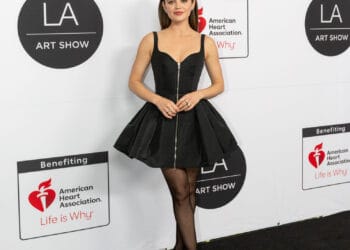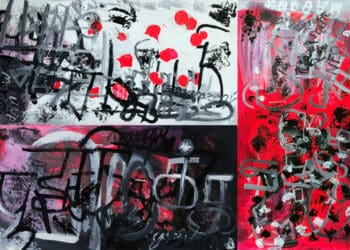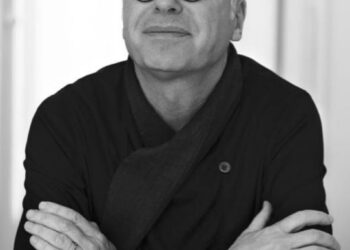Review by Moira Cue

There may be a little personal bias going on, but this year—2018— was my favorite year at the LA Art Show. The modern, contemporary, art and design objects, China, jewelry and Old Masters sections were all combined into one open floor plan, with greatly widened aisles. The result was less elbow-to-elbow pushing and shoving and more room to breathe. Additionally, gone were some of the more theatrical, over-the-top shock artists. With installations like Antaun’s “Left or Right,” and his partner Luce, there was a focus on healing.
Antuan Rodriquez is a Cuban artist whose installation of lightweight red punching bags allowed visitors to punch their favorite dictator. Along with notorious butchers, despots, serious control freaks, and murderers, the artist included the face of two recent Republican American presidents. One of whom was extremely popular as a punching bag, in stark contrast to the many artists who were inspired in 2008 to create iconic, positive images of Barack Obama.
I met Antuan’s partner, Luce, in line near the espresso bar and again in front of two of my paintings which made a brief appearance at Bruce Lurie Gallery. I didn’t know they were part of the programming, but I was drawn to their all-white clothes and the gold temporary tattoos Luce was wearing on her face and below her clavicle. I described the positive intention of my paintings—to emanate abstract virtues and stimulate cross-cultural conversations—and Luce told me she was a medicine woman, and invited me to be a participant in a performance on Sunday, the closing day.
Participants in white chanted “om” and proceeded through the gallery to the punching bag installation, where we played Tibetan singing bowls, chanted some more, and then watched a man named Ceasar perform a Latino version of the whirling dervish dance, spinning on his head with a biker’s helmet on. The intention behind the performance was to offer an alternative to the aggression and male dominance symbolized by the punching bags. (note: I do not believe Luce was listed separately in the programming, so I don’t know if I am correctly crediting her or her full name). The piece was listed as a part of Antuan’s installation.
This was a year where women and people of color had a greater presence than in some previous shows, and that is definitely a positive and led to the opportunity to have some real conversations. Jane Szabo, a photographer and conceptual artist, chided me about my sky-high heels. I wasn’t even wearing them when we met, but carrying them while trekking with my flip flops. In years prior, I received odd looks for ‘not’ wearing them rather than direct comments that I should just ditch them entirely instead of soldiering on as long as possible. I’m glad she started a conversation because I was able to learn more about her work.
Szabo discussed with me photographs of objects that related to memory, aging, and loss. “I read a novel with a line that stood out to me,” she said. “The last thing your parents teach you is how to die.” Szabo is currently dealing with her parents’ aging as an emotional source of contrast in her still life. The work suggests domesticity and the passage of time with an intimate but ultimately inaccessible urgency. My favorite image is “Secrets” from the Family Matters series. It is a diary with a padlock, covered in rough grey stones. The image is iconic and powerful.
Another super cool artist I was able to meet was Chukes, an Altadena- based sculptor who was present with his wife Rhonda. I started up a conversation with Chukes about the work of one of his friends, Tim Washington; whose work utilizing found objects and kitsch (placed on the outer parameters of the gallery) is funky, whimsical, and yet deeply spiritual. Chukes’ figurative work I was fortunate to have described to me celebrates womanhood and exposes the psychological limitations placed on African-American men culturally as illusions. That is not to say that we don’t all have cultural expectations that can be harmful; it is to say that we are free to move beyond what is expected of us. If we realize we have the choice.
More LA galleries, and more downtown LA galleries, made strong showings this year. Chris Davies, director of Fabrik Projects, is not only running an art publication (Fabrik Magazine) but also made a very strong showing with the project space and a lot of consistent, great work. BG Gallery from Santa Monica was everywhere. And the quality of downtown LA galleries, which used to be spotty with a few bright lights, is becoming an undeniable force. Gallerist Renee Warren of Ren Gallery and Luke at Cordesa Fine Art were approachable, smart, and both located in DTLA. Cordesa had a tightly curated group of artists whose work was both conceptually and technically precise; I particularly enjoyed Martin Machado’s psychological aquatic landscapes with a contemporary psyche and an antique etched feel and the brightly colored wood relief sculpture of Sean Newport. Ren Gallery had mandala-themed works on sale that caught my eye immediately on entering the hall from an artist named Aiseborn, who was creating a mural in residence on opening night.
On Wednesday night I met a woman named Chakra who also knew Aiseborn; she met him when he knocked on the door of their loft/commune and asked if he could tag their wall. Chakra discovered that Aiseborn was homeless, and the group decided to provide housing for Aiseborn for a year and a half. The artist is now in the Getty Museum collection and doing very well. His work also has a spiritual vibe, with titles like “purity” and figures that seem influenced by Mayan and Incan artifacts. Although he is a street artist, his work looks more like the socially conscious murals of the sixties and seventies than work inspired by graffiti and urban music.
Art All Ways represented smaller scale work by hot L.A. street artist Retna, along with a very popular installation of ceramic donuts by Jae Yong Kim and giant candy bars by artist Daniel Allen Cohen, who brought his adorable bulldog to sit at the booth one evening. Performance artist Pandemonia, outfitted head to toe like a plastic doll, attracted a lot of attention.
There was texture by ceramic artist Sharon Hardy, and neuroscience-inspired projects on empathy and synesthesia, and a ballpark with a trio of alternate selves; a Skid Row-inspired cast of characters in a staged postmodern reference to the Death of Marat, also titled Death of Marat, by Daniel Joseph Martinez, who was also in attendance Wednesday night and surrounded by curious patrons.
The newly discovered Gil Cuatrecasas work was prominently represented, with a highly professional team working to give the artist the support and recognition he deserved while he was still living but didn’t receive until later. I absolutely love this work.
The work that the gallerists do on behalf of artists is not easy, and often overlooked. One quality of a great art dealer is bonhomie—a general goodwill toward people—and spending more time at the Bruce Lurie Gallery this year, I was impressed by the Lurie brothers’ openness and general good nature toward the show attendees. It’s no wonder their booth was always full of people. Pop artist Nelson De La Nuez showed some new works on custom-made paper; created by the same folks who bring us spiral bound notebooks, but in a giant size. Andrea Bonfils showed highly technical mixed media works with a floral theme that looked like candy-colored floral holograms. Michael Gorman’s colorful, expressive work elicited a lot of interest, also.
I was excited to find the Paris-based Galerie Bruno Massa, exhibiting the work of Gilles Teboul. Teboul’s work was described in the gallery’s literature “in the purest archeiropoïetic tradition …. (a) Greek term (that) means ‘not made by the hand of man, miraculously.” The artist demonstrates mastery of the surface reflection through poured resin over gorgeous, crepuscular color fields of a halcyon dream. The entire collection clearly belonged in a museum.
On a final, upbeat note, the Lincoln Navigator on display was there not only to turn heads but to support St. Jude’s. For every person who gave her personal information, the company donated $50 to St. Jude’s Childrens Hospital. And then they gave you a box of truffles—a sweet reward for a simple act of kindness.







